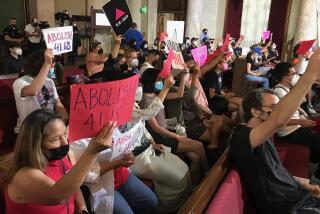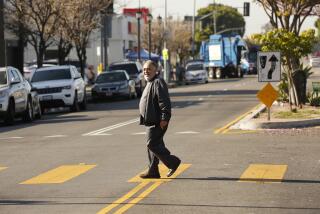More large electronic billboards are possible for downtown Los Angeles after governor’s action
More large electronic billboards are possible for downtown Los Angeles after governor’s action
More electronic billboards could be allowed in downtown Los Angeles under a new law signed Friday by Gov. Jerry Brown that community activists charge will add to visual blight in the city core.
The controversial bill allows developers to erect several giant electronic billboards around the $1-billion Metropolis high-rise project in downtown Los Angeles as long as they also are allowed by the city.
The measure is opposed by Dennis Hathaway, president of the Coalition to Ban Billboard Blight, who said it will create an atmosphere of flashing, changing electronic signs like Times Square in New York City and cause a dangerous distraction for motorists on nearby streets and the 110 Freeway. He also said it would create an eyesore.
“I’m really disappointed,” Hathaway said. “Having big, multistory advertisements for things like beer and Coca-Cola is not the highest and best use of the visual environment.”
He also said the law sets a bad precedent for allowing a developer to get legislators to grant exemptions from state sign laws limiting billboards near freeways.
Assemblyman Miguel Santiago (D-Los Angeles) said his measure is aimed at helping the economic revitalization of a downtown neighborhood. The measure is needed to provide some financial incentive for developers to revitalize the city core now that redevelopment agencies have all been shut down, the lawmaker added.
Billboards can provide extra revenue to help make developments more profitable, he said. The bill provides exemption from the Outdoor Advertising Act for an area bounded by West 8th Street on the northeast, South Figueroa Street on the southeast, Interstate 10 on the southwest, and State Route 110 on the northwest, and to a nearby area on the westerly side of State Route 110 bounded by West 8th Place, James M. Wood Boulevard and Golden Avenue.
“I’m hoping it will spark up the much-needed revenue to make development happen in downtown Los Angeles and create thousands of jobs and hopefully become more of a world city,” Santiago said Friday, adding it could help the area targeted to become “an anchor like we saw with L.A. Live.”
Santiago said the city of Los Angeles, which will have final say on any signage, has lost $5 billion in economic development over the last four years alone because of the lack of hotel rooms and an outdated Los Angeles Convention Center.
The Los Angeles Metropolis project, which includes 350 hotel rooms, is a 6.3-acre, $1-billion development adjacent to LA Live that is expected to bring $156.7 million in tax revenue into the city over the next 25 years, he said.
Brown also signed a bill exempting two existing advertising billboards along Interstate 405 in Inglewood from the Outdoor Advertising Act restrictions on changeable, electronic signs through Jan. 1, 2023.
Latest updates
More to Read
Get the L.A. Times Politics newsletter
Deeply reported insights into legislation, politics and policy from Sacramento, Washington and beyond. In your inbox three times per week.
You may occasionally receive promotional content from the Los Angeles Times.






